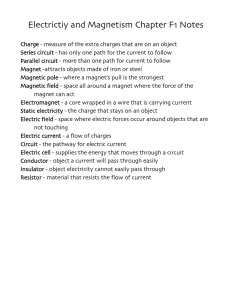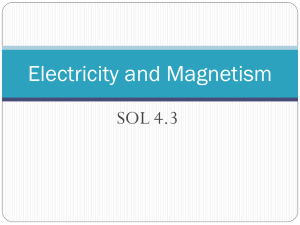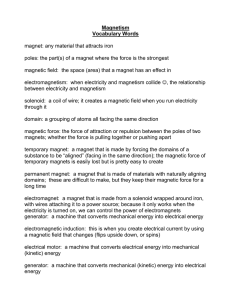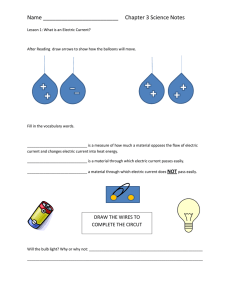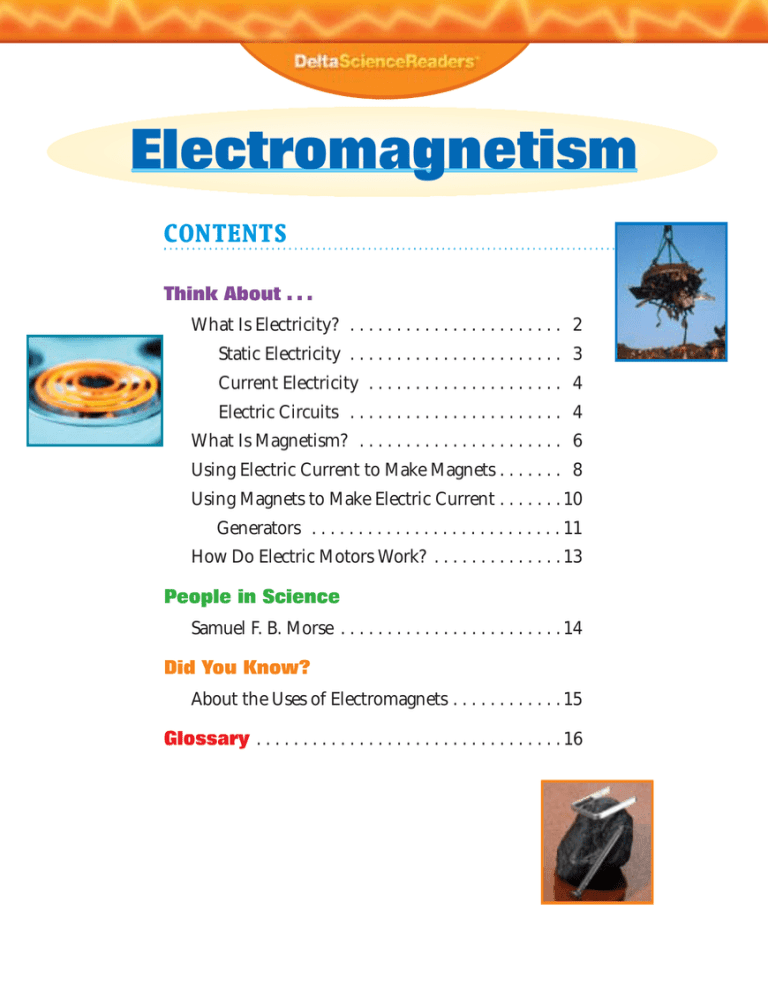
Electromagnetism
CONTENTS
Think About . . .
What Is Electricity? . . . . . . . . . . . . . . . . . . . . . . . 2
Static Electricity . . . . . . . . . . . . . . . . . . . . . . . 3
Current Electricity . . . . . . . . . . . . . . . . . . . . . 4
Electric Circuits . . . . . . . . . . . . . . . . . . . . . . . 4
What Is Magnetism? . . . . . . . . . . . . . . . . . . . . . . 6
Using Electric Current to Make Magnets . . . . . . . 8
Using Magnets to Make Electric Current . . . . . . . 10
Generators . . . . . . . . . . . . . . . . . . . . . . . . . . . 11
How Do Electric Motors Work? . . . . . . . . . . . . . . 13
People in Science
Samuel F. B. Morse . . . . . . . . . . . . . . . . . . . . . . . . 14
Did You Know?
About the Uses of Electromagnets . . . . . . . . . . . . 15
Glossary . . . . . . . . . . . . . . . . . . . . . . . . . . . . . . . . . 16
Glossary
atom smallest unit of a substance that still
has all the properties of that substance
conductor material through which electric
current passes easily
current electricity electric charges that
can flow steadily through a material; also
called electric current
domain group of atoms whose magnetic
fields are lined up with one another
electric charge basic property of matter
that can be positive or negative and that
changes when matter gains or loses electrons
electric circuit closed path along which
electric current flows
electric energy form of energy that results
from the way electrons behave
electricity interaction of electric charges;
can be static (at rest) or current (flowing)
electric motor device that uses magnets
to change electric energy into mechanical
energy
magnet material that has a magnetic field
around it and so attracts metals containing
iron, cobalt, or nickel
magnetic field space around a magnet
where the force of the magnet acts
magnetic poles places on a magnet where
the magnetic force is the strongest
magnetism force of a magnet that attracts
the metals iron, cobalt, and nickel and
materials that contain these metals
mechanical energy form of energy
produced by a moving object
neutron tiny particle that is part of the
nucleus of an atom; a neutron has no
electric charge
nucleus center of an atom
parallel circuit circuit that connects two
or more objects so that the current flows
along a different path to each object
permanent magnet magnet that holds
its magnetic properties for a long time
electromagnet temporary magnet made
when electric current flows through a wire
wrapped around an iron or steel core
proton tiny particle that is part of the
nucleus of an atom; a proton has a positive
electric charge
electron tiny particle that moves around
the nucleus of an atom; an electron has a
negative electric charge
resistance measure of how well a material
resists the flow of current through it
energy ability to cause changes in matter
or do work
field lines invisible lines around a magnet
that show the direction and strength of the
magnetic field; also called lines of force
generator device that uses magnets to
change mechanical energy into electric energy
insulator material through which electric
current does not easily pass
series circuit circuit that connects two or
more objects, one after the other, so that the
current flows in a single path to all objects
static electricity electric charges at rest
that can build up on a material and discharge,
or jump from one material to another,
but do not flow steadily
switch device used to start and stop the
flow of electric current in a circuit
temporary magnet magnet that loses its
magnetism after a short time
© Delta Education LLC. All rights reserved.
16

